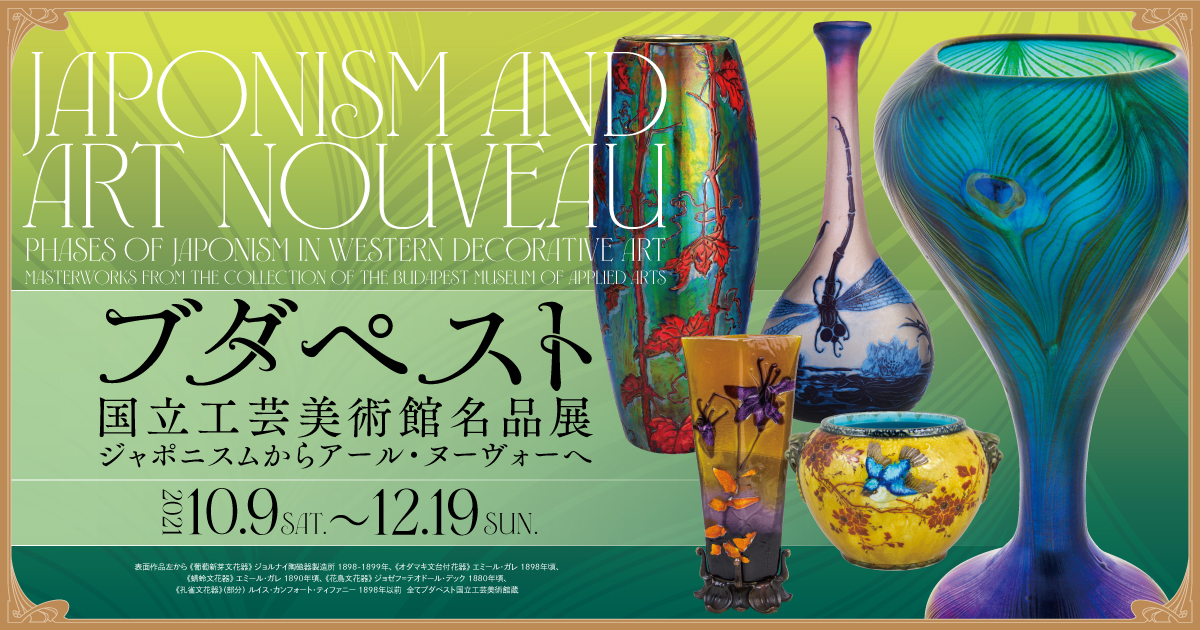Japonism and Art Nouveau
Phases of Japonism in Western Decorative Art
- Masterworks from the Collection of the Budapest Museum of Applied Arts

Japonism and Art Nouveau
Phases of Japonism in Western Decorative Art
- Masterworks from the Collection of the Budapest Museum of Applied Arts
To prevent the spread of COVID-19, we would like to request that you reserve the date and time of your visit in advance from our reservation website.
All advance reservations are no longer accepted.
- The admission fee is to be paid upon your visit.
- We are not accepting reservations by phone or at the museum reception.
General Information
- Dates
- October 9 - December 19, 2021
- Hours
- 10 a.m. – 6 p.m. (Admittance until 5:30 p.m.)
* Open until 8 p.m. (Admittance until 7:30 p.m.) on November 5 and December 3.
- Closed
- Wednesdays (Except for November 3)
- Admission
- Adults: ¥1,000
Visitors aged 65 or over carrying proof of age: ¥900
Students (College): ¥700
Students (High / Middle school): ¥500
Admission is free for children in primary school and younger.
Admission is free for disability passbook holders and up to one accompanying adult.
- Organizers
- Panasonic Shiodome Museum of Art, The Mainichi Newspapers
- Supporters
- Embassy of Hungary, Liszt Hungarian Cultural Institute Tokyo, Minato City Board of Education
- Cooperation
- Lufthansa Cargo AG, Lufthansa German Airlines
- Planning support
- Art Impression Inc.
Exhibition overview
Crafts from Japan and China have long been viewed as objects of admiration in the West. In the fields of ceramic and glasswork in particular, Western artists have continually experimented with materials, forms, and ornamentation based on Japanese and Chinese models.
In the late 19th century, Japanese art works and crafts began to arrive in Europe, creating a craze for all things Japanese, and subsequently exerting an influence on Western crafts and design. The reopening of Japan in 1854, following a lengthy period of national isolation, spurred trade with the West, including the export of countless works of art and crafts intended to meet the demands of enthusiasts in Europe and America. This admiration for Japanese culture, and for Japan itself, led to the rise of the Japonism fad among Western artists and designers. This in turn exerted a significant influence on Art Nouveau, a style that was sweeping through Western countries in the late 19th century. And as with many other craft museums in Europe, since its opening in 1872, the Budapest Museum of Applied Arts has actively collected Japanese crafts, such as lacquer ware and ceramics, along with Japonism-style works.
This exhibition examines how Japanese art was interpreted in the West, and how Japanese art and crafts influenced the West through a sampling of works dating from the final years of the 19th century to the beginning of the 20th century. Based on the themes of Japonism and Art Nouveau, the exhibition presents approximately 170 works (200 pieces) from the Budapest Museum of Applied Arts Collection. These include exemplary Hungarian works, including those produced by the Zsolnay Factory, and masterpieces by designers such as Émile Gallé and Louis Comfort Tiffany.





